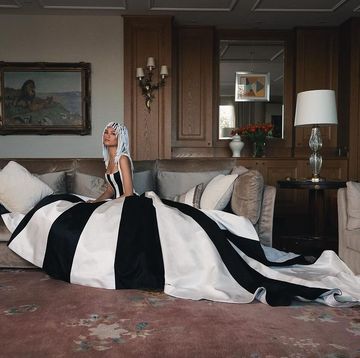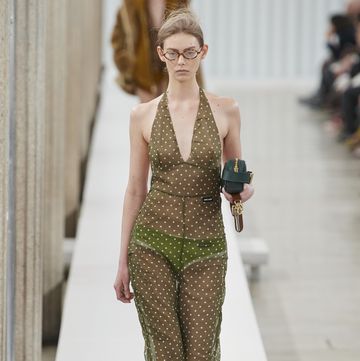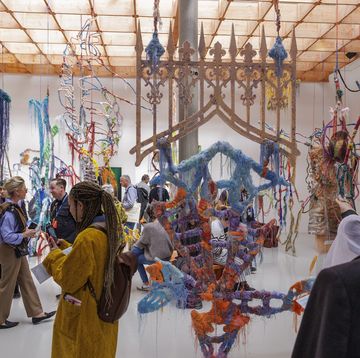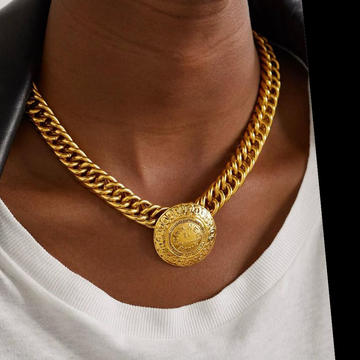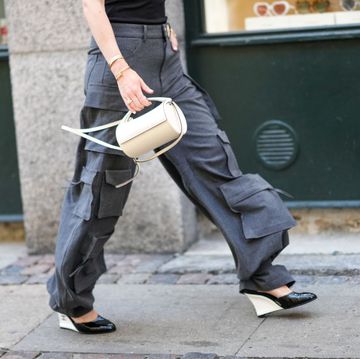Justin Thornton remembers the day he met his business partner and wife Thea Bregazzi very clearly. 'It was at the tech college on the Isle of Man, where we are from. It was the first day of Art Foundation and we were sat next to each other, waiting in the corridor, don't you remember?' Thea, tickled, does not. So Justin continues. 'You were wearing, I think, Levi's 501 jeans, Doc Martens, a black polo neck, and you had a big leopard print scarf tied up in your hair like a bow,' he adds unintentionally describing a slightly tomboyish, slightly girly, rocker look the two would go on to make famous with their line Preen, reimagining the signature on and off throughout the seasons (with a few departures here and there) all the way up to their most recent, stunning aw16 show.
The grunge-punk-goth girl is big news at the moment, but Justin and Thea absorbed the aesthetic in their youth (Justin the son of a childcare worker and manager of a textile company and Thea the daughter of a nurse and electrician-turned-famous-motorbike-racer.) 'What was great about it was there was only one club on a Friday night and one club on a Saturday that anyone vaguely arty or cool or whatever went to and so they played punk music, goth music, new romantic, pop,' he says. 'Everybody just mixed together,' Thea adds. We're sitting in the couple's West London studio having tea, while various assistants and atelier workers pack up their latest take on rock 'n' roll cool (embellished dark floral and plaid dresses, a series of pink jaw-dropper versions in velvet and sequin and bejeweled Derby boots) for a week of press and buyer appointments in Paris.
A lot has changed since Justin and Thea first opened their business two decades ago after working as a consultant and stylist respectively. That was before the UK fashion market became a £26 billion industry and before ecommerce and social media came along to disrupt it. They're turning 20 against the backdrop of a 'broken fashion system' in which designers, buyer and editors have debated how to correct an industry calendar in which the frequency of collections being created and timing in which its produced and shown no longer seems to work in the digital age. Nevertheless they've somehow managed to thrive in a market in which many of their peers, including Jonathan Saunders and Matthew Williamson, have had to close or restructure their businesses. To date, Preen produces four mainline and two Preen Line collections per year, alongside eyewear and childrenswear. They also have a new exclusive capsule at Net-a-Porter hitting stores this month. And their cultish fanbase of British cool girls (founding members include Liberty Ross and Kate Moss and later Amy Winehouse) has expanded and evolved (Alexa Chung, Gwyneth Paltrow, Diane Kruger, Scarlett Johansson, Michelle Obama, the list goes on and on.)
'When we started there was no Internet. And you only saw a designer's collection when the magazine came out, and that was four months after it had first been shown,' Thea explains. She says they use social media channels like Instagram as a tool for marketing and discovery, but ultimately try to resist the manic conversation about the fashion system and focus on evolving their work. 'I think anything new and exciting — people will embrace it,' Justin says.
In their case, that means reimagining the signature brand of cool they started with. 'When we started, our label was a lot darker, more raw and it kind of reflected what we were doing — partying and clubbing — at the time. But now, we're not really clubbing so much these days. We're going out to lovely dinners. And the collection reflects that more,' Thea says. 'She's still very rock 'n' roll. She still might go to music festivals but at the same time she's in the boardroom or she's on the beach in the Seychelles. We're lucky to know so many people from those days who are really successful but still grounded in that arty cool attitude to life.'


